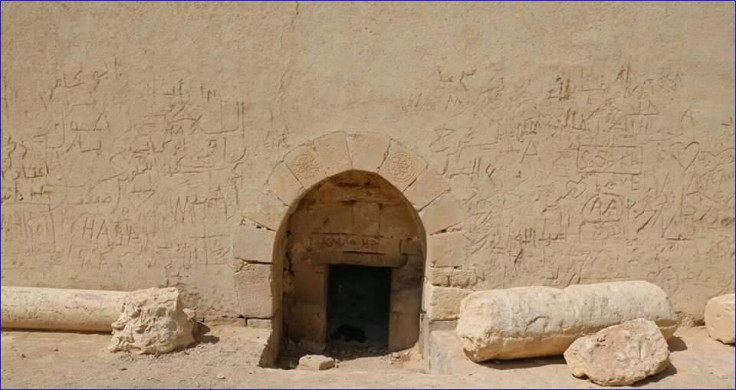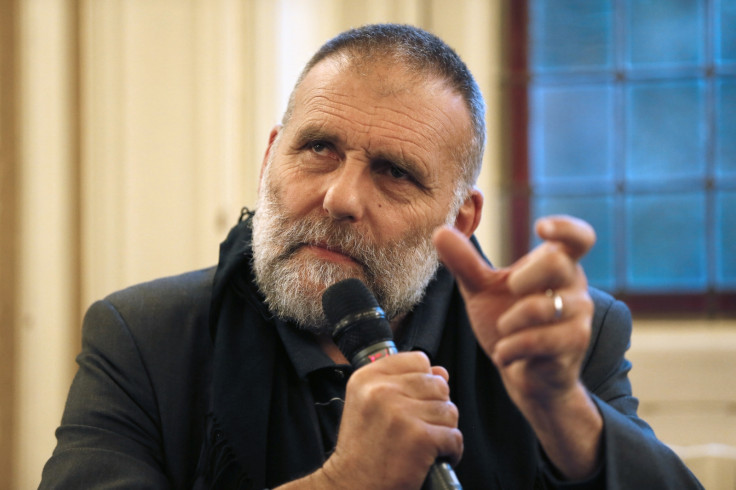Syria: Ancient Mar Elian monastery bulldozed by Isis was interfaith experiment in divided country

Every summer for three years, Emma Loosley was the only inhabitant and custodian of Mar Elian, an ancient Syrian monastery nestled in the remote but strategic town of Qaryatain, a three-hours drive from Homs. The monastery priest, Father Jacques Mourad, was living in the parish house attached to the village church and Loosley, a British archaeologist at the University of Exeter, used to receive regular daily visits from the site's guardian,- at 9am and at sunset.
In the evening, people from the small community of Qaryatain, Christians and Muslims alike, would come to visit and worship at the tomb of Mar Elian el-Sheikh – Saint Julian the Old. Loosley would sit with them, have a cup of tea and listen to old stories about the monastery, which has been inhabited continuously for at least 1,500 years.
One of these stories, which reveals the profound interfaith inspirational qualities of the monastery, involves the Muslim medieval ruler of the area, Emir Sayf Ed Dawleh. Inside the ancient entrance to the shrine, a modest door surrounded by crumpled columns, an inscription signed by the Emir and dated 1419 reads: "This is a holy place and everybody here is protected." Everybody, be it Muslim or Christian.
'IS are not real Muslims'
That door, with its inspiring human inscription, has been reduced to rubble by bulldozers operated by militants of Islamic State (Isis), who recently captured Qaryatain from Syrian regime forces and kidnapped dozens of Syriac Catholic and Syriac Orthodox families.
Pictures shared on IS-linked social media accounts show jihadists destroying the medieval walls and the site of the excavation of a part of the monastery dating back to the 13th century and topped with a wooden roof by the local community to protect the fragile mud bricks.
But it is more than just stones and ruins that IS shattered with iconoclastic fury. With them went an interfaith ideal devoted to Islam-Christian dialogue, which bred and prospered in the local community thanks to inspired priests such as Mourad and Father Paolo Dall'Oglio. Both of them have been kidnapped by Islamist groups: Dall'Oglio in 2013, Mourad in May 2015. Nobody knows what happened to them. Nobody claimed responsibility or asked for a ransom. They just disappeared.
"Mar Elian has been a shrine for Muslims as well as for Christians for 1,500 years," Loosley told IBTimes UK. "The Muslims of Qaratayin revered Saint Julian the same way as Christians did and they are going to be just as devastated as them about this. That shows that IS are not real Muslims. If they were true Muslims they wouldn't be doing this."
Interfaith dialogue

Loosley founded the Dayr Mar Elian Archaeological Project (DMEAP) in 2001 and worked on an excavation there until 2004. She was only the third foreigner to travel to the area since the early 20th century. "I was kind of adopted as their foreigner by the local community," she said. "Before me only a Scandinavian missionary in the 1920s and Gertrude Bell had been there. It was curious that I was the second British archaeologist after her to join the community."
Loosley was asked to set up the project by Dall'Oglio, a close family friend, when the Community of al-Khalil at Mar Musa took responsibility for Mar Elian by the Syrian Catholic Metropolitan of Homs, the late Msgr Georges Kassab.
Based around the 5th-century sarcophagus of Saint Julian, Mar Elian was continually inhabited from late antiquity to the early 19th century but had fallen into disuse. The idea was to transplant to Mar Elian the glimmering example of Mar Musa, the mountainous monastery that became a beacon of hope in a divided region and a gathering ground for interfaith dialogue under the Jesuit Dall'Oglio.
Mar Elian badly need restoration, and the Metropolitan of Homs believed a newly renovated monastery could bring in tourists and generate income for the local population. That strategy went together with the social education programme that was being put in place by Mourad. Until then, no regular priest had been resident of the monastery.
Just like Mar Musa, Mar Elian had fallen into disuse at the beginning of the 19th century when many Orthodox monasteries fell into the hands of the Catholic church. Local people kept the shrine going and the Christian Bedu family lived in the shrine as guardians.
"Qaratayin is one of the poorest places in Syria, it being so remote. Fr Jacques [Mourad] set up an educational system for the children, a social support network and sharecropping initiatives," Loosley said.
Mar Elian - Sheikh Ahmed

Digging in the shared history of the sacred site, Mourad worked hard to reach out to the local Muslim community. After some initial resistance, Muslim workers from local villages started taking part to the excavation on the site. People began to open up, recount memories of the monastery, taking part in the life of the community. Soon, it became another inclusive instance of dialogue between Christians and Muslims in dark times.
"On the 9th of September, which is the saint's day, the sheikh of the village used to come along with the local bishop. They stood up and talked about the importance of the saint to the village," Loosley said. "Muslims had their name for him: they called him Sheikh Ahmed the Priest. The sarcophagus itself was covered in a green satin silk cover, which the local Muslim population put there and Christians allowed them to do that.
Not as picturesque as Mar Musa, Mar Elian became popular with Syrians, not foreign tourists, who set up summer camps for Syrian teenagers there. After civil war broke out, Mourad would use the monastery to host refugees from across the neighbouring areas. And there were more Muslim refugees than Christians until he was kidnapped.
"The vast majority of people he was protecting were Muslim families escaping fighting in Homs," Loosley said.
'We'll not let these people divide us'

After the massacre of 45 Christians in Sadad at the hands of the al-Qaeda-linked Nusra front in October 2013, the Muslim-majority village of Hawwarin was targeted. A number of houses were destroyed and people started to flee to nearby villages, including Qaratayin and the Mar Elian monastery.
"Fr Jacques decided to raise money from the local community, so the refugees who came could come back and rebuild their house there," Loosley said.
Along with the local Muslim Sheikh, Mourad formed a local committee for interfaith dialogue. "We will not let these people divide us, we will take a united stand," was their motto.
Local myths say St Julian the Old was the teacher of St Catherine of Alexandria, one of the most revered Syriac saints to both Catholics and Orthodox. According to the legend, he was travelling on a ox cart from Mesopotamia to Jerusalem and on his way back he died, leaving dispositions to bury his body where the ox would eventually stop. That place is the shrine at Qaratayin.
Despite her intimate association with the monastery, Loosley is not shocked, nor surprised by the pictures shared on social media. "I'm kind of numb at the moment," she said. "I have a series of close people who have been kidnapped, or forced to flee. Friends from Qaratayin living in Italy or other parts of Europe who can't trace all their relatives. Paolo [Dall'Oglio] and Jacques [Mourad] were close friends.
"It's just one thing on top of another," she said. "Last time I spoke to Fr Paolo was two years ago, on my wedding day, ironically. It was just a couple of months before the kidnapping."
© Copyright IBTimes 2025. All rights reserved.




















